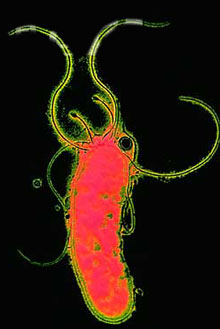The Next Human Genome Project: Our Microbes
Much as we might like to ignore them, microbes have colonized almost every inch of our bodies, living in our mouths, skin, lungs, and gut. Indeed, the human body has 10 times as many microbial cells as human cells. They’re a vital part of our health, breaking down otherwise indigestible foods, making essential vitamins, and even shaping our immune system. Recent research suggests that microbes play a role in diseases, such as ulcers, heart disease, and obesity.

While microbes make up such an intimate part of us, most of our microbial inhabitants remain a mystery. The bacteria in the human body are very difficult to study, since only about 1 percent of them can be grown in the lab. Now a proposed new project to sequence all our microbial residents could change that.
“This is completely unexplored territory that is likely to have a large impact on our understanding of human health and disease,” says George Weinstock, codirector of the Human Sequencing Center at the Baylor College of Medicine, in Houston. “We hadn’t been able to approach it because of the scale of the problem. But now we are finally able to open that door.”
Thanks to ever-improving methods to sequence DNA, scientists can now analyze the genomes of entire microbial communities, a field known as metagenomics. By comparing microbial communities in people of different ages, origins, and health statuses, researchers hope to find out precisely how microorganisms prevent or increase risk for certain diseases and whether they can be manipulated to improve health.
Several metagenomics projects are under way or have been completed, including analysis of the microbes living in the human gut and on the skin. But a true snapshot of our microbial menagerie will require a massive effort, along the lines of the Human Genome Project. “Even though a microbial genome is one-thousandth the size of the human genome, the total number of microbial genes in [the human] body is much greater than human genes because you have so many different species,” says Weinstock.
The National Institutes of Health (NIH) is now considering such a project. Metagenomics experts and government officials met last week to determine if the proposal, dubbed the human microbiome, will become an NIH “Roadmap” initiative. These NIH-wide programs identify major gaps in biomedical research and provide financial support on a much larger scale than typical grants. A final decision is expected this month.
“At the end of the day, we’ll end up with another perspective on the evolution of our species, our human-microbial selves,” says Jeffrey Gordon, a microbiologist at the Washington University School of Medicine, in St. Louis.
Recent research from Gordon’s lab hints at the potential public-health impact of a clearer understanding of our microbial tenants. Gordon and his colleagues have shown that obese people harbor different microbial communities than lean people. And as obese people lost weight, their microbes began to look more like their lean counterparts’ microbes.
Researchers aren’t yet sure what triggers the differences, but they found in a similar study in mice that the microbial populations of obese mice could more effectively release calories from food during digestion than could microbes of their lean littermates.
While exciting, Gordon’s research also illustrates the challenges of cataloging microbes. To truly interpret the human microbiome, scientists will need to look at the variation in microbial communities among many people and a variety of populations. Complicating the problem is that, while an individual’s human genome is static, a person’s microbial composition–and thus his or her microbiome–fluctuates over time. So an accurate picture of one person’s microbiome could require multiple resequencing efforts.
These types of studies could yield the biggest reward, revealing whether different organisms are correlated with different health states. Gordon and others hope that a microbial analysis will ultimately become a routine part of medical exams, perhaps used to diagnose different diseases.
Scientists are still debating whether the microbiome will become a road-map project, and if so, what the final goals of the project will be: should they focus on generating complete sequences of dominant microbes, for example, or devote equal energy to the complex task of studying microbial variation?
In the meantime, microbiologists are getting ready. Three large sequencing centers–at Baylor, the Broad Institute, and Washington University–have garnered funding to sequence the genomes of a few of the gut microorganisms that can be grown in the lab, which will be crucial in later studies. Ultimately, says Gordon, “we’ll get a much more transcendent view of ourselves as a supraorganism with traits acquired from our microbial partnerships.”
Keep Reading
Most Popular
Large language models can do jaw-dropping things. But nobody knows exactly why.
And that's a problem. Figuring it out is one of the biggest scientific puzzles of our time and a crucial step towards controlling more powerful future models.
The problem with plug-in hybrids? Their drivers.
Plug-in hybrids are often sold as a transition to EVs, but new data from Europe shows we’re still underestimating the emissions they produce.
Google DeepMind’s new generative model makes Super Mario–like games from scratch
Genie learns how to control games by watching hours and hours of video. It could help train next-gen robots too.
How scientists traced a mysterious covid case back to six toilets
When wastewater surveillance turns into a hunt for a single infected individual, the ethics get tricky.
Stay connected
Get the latest updates from
MIT Technology Review
Discover special offers, top stories, upcoming events, and more.